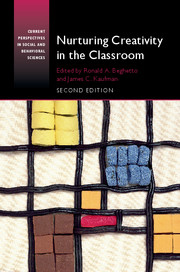Book contents
- Frontmatter
- Dedication
- Contents
- Preface
- Acknowledgments
- PART I VOICES FROM THE FIELD
- PART II VOICES FROM THE RESEARCH
- 5 Developing Creativity Across All Areas of the Curriculum
- 6 Accountability, the Common Core, and Creativity
- 7 Ever-Broadening Conceptions of Creativity in the Classroom
- 8 Creativity in Mathematics Teaching: A Chinese Perspective (An Update)
- 9 Roads Not Taken, New Roads to Take: Looking for Creativity in the Classroom
- 10 The Five Core Attitudes and Seven I's of the Creative Process
- 11 Creativity Embedded into K–12 Teacher Preparation and Beyond
- 12 Attitude Change as the Precursor to Creativity Enhancement
- 13 Nurturing Creativity in the Engineering Classroom
- 14 Intrinsic Motivation and Creativity in the Classroom: Have We Come Full Circle?
- 15 Learning for Creativity
- 16 Creativity and Prosocial Values: Nurturing Cooperation within the Classroom
- 17 How Social-Emotional Imagination Facilitates Deep Learning and Creativity in the Classroom
- 18 Four Faces of Creativity at School
- 19 Teaching for Creativity
- 20 A Coda for Creativity in the Classroom: Take-Home Points and Final Insights
- Index
- References
9 - Roads Not Taken, New Roads to Take: Looking for Creativity in the Classroom
from PART II - VOICES FROM THE RESEARCH
Published online by Cambridge University Press: 24 November 2016
- Frontmatter
- Dedication
- Contents
- Preface
- Acknowledgments
- PART I VOICES FROM THE FIELD
- PART II VOICES FROM THE RESEARCH
- 5 Developing Creativity Across All Areas of the Curriculum
- 6 Accountability, the Common Core, and Creativity
- 7 Ever-Broadening Conceptions of Creativity in the Classroom
- 8 Creativity in Mathematics Teaching: A Chinese Perspective (An Update)
- 9 Roads Not Taken, New Roads to Take: Looking for Creativity in the Classroom
- 10 The Five Core Attitudes and Seven I's of the Creative Process
- 11 Creativity Embedded into K–12 Teacher Preparation and Beyond
- 12 Attitude Change as the Precursor to Creativity Enhancement
- 13 Nurturing Creativity in the Engineering Classroom
- 14 Intrinsic Motivation and Creativity in the Classroom: Have We Come Full Circle?
- 15 Learning for Creativity
- 16 Creativity and Prosocial Values: Nurturing Cooperation within the Classroom
- 17 How Social-Emotional Imagination Facilitates Deep Learning and Creativity in the Classroom
- 18 Four Faces of Creativity at School
- 19 Teaching for Creativity
- 20 A Coda for Creativity in the Classroom: Take-Home Points and Final Insights
- Index
- References
Summary
A river runs through a village somewhere. And for many years, it is just a river, feeding the rice paddies, carrying away waste, silt, pebbles, and the occasional dog or cat. But one day, without even consciously trying, someone realizes that it is a road, a way out. And later that someone wonders why he or she did not see it before – that the river is a road and that the road can be a river – even though it had been there all along.
And so we are beginning to realize with creativity that it has always been in the classroom but hidden in plain sight. It is not that creative behavior, creative thinking, and creative learning never existed before in classrooms. A colleague recalls once proposing an unconventional subject of study for a senior project in high school. While his classmates took up the ubiquitous topics of various sports, medicine, feminism, and other well-recycled subjects, he decided to review the history and legitimacy of parapsychology. His topic was firmly rejected. However, being a persistent fellow, he undertook it anyway, approached it seriously, and presented an interesting and worthy paper in the end that earned a high mark. But why was his innovation and unconventional thinking not recognized initially as a form of creativity?
In this chapter, we examine the evolving and exploratory relationship between teachers and creativity in the classroom. Our emphasis in the chapter is that teachers’ implicit theories of creativity are often at variance with explicit theories of creativity – that is, what the teachers may value as creative behaviors are actually noncreative, and what they devalue as not creative behaviors may be creative. As a result, teachers may think they are developing creativity when, in fact, they are suppressing it. In the hands and minds of researchers and theoreticians, creativity has been viewed through many lenses and explored in a variety of lights for the last 60 years. But what effect has this had on teaching in the classroom? And has it helped teachers identify and nurture creative behavior in the context of school?
- Type
- Chapter
- Information
- Nurturing Creativity in the Classroom , pp. 108 - 130Publisher: Cambridge University PressPrint publication year: 2016
References
- 1
- Cited by

